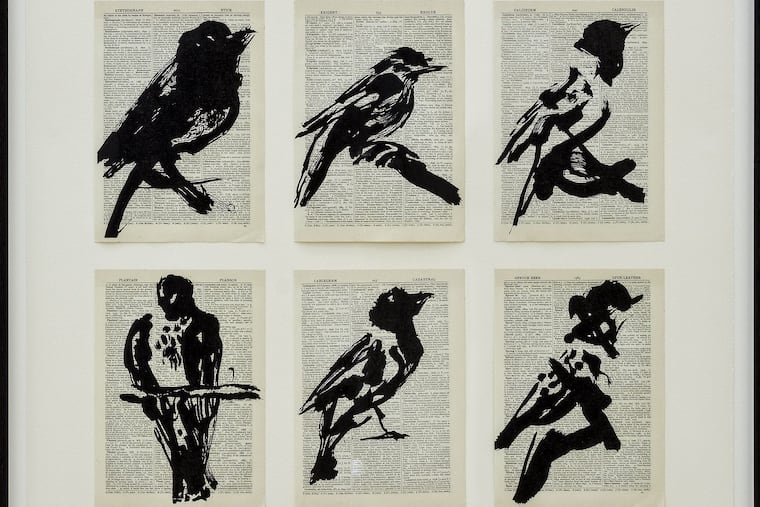In Philly galleries now: William Kentridge linocuts, UK roadside views, painted Philadelphia
New shows at Locks Gallery, Gross McCleaf, and UPenn's Arthur Ross Gallery are some September must-sees.

William Kentridge's drawings, prints, and animated films have surprised, elated, and disturbed gallery- and museumgoers since the late 1990s, when the South African artist, who had studied acting and worked as an art director of television films, acquired an international reputation for his art. Audiences were captivated by his animated films of his charcoal drawings depicting him as an everyman on the fringes of the anti-apartheid movement.
Now, in a traveling exhibition on view at the University of Pennsylvania's Arthur Ross Gallery, Kentridge expands on his art-making process in a body of work he completed in 2012.
"Universal Archive," organized by the Gund Gallery of Kenyon College, gathers 79 linocut prints of subjects that have become part of Kentridge's personal iconography over the years — coffeepots, cats, trees, nudes, typewriters — all based on his expressionistic calligraphic ink drawings.
Many of those subjects are depicted in groups of prints gradually shifting from their original recognizable states to a few abstract marks, as in Six Birds, comprising six prints of birds in various stages of deconstruction.
According to a wall text, Kentridge began making the linocuts for "Universal Archive" himself but quickly handed the project over to more experienced hands.
"Here the task was to see how accurately one could follow the India ink on the block edge of lino — in other words, trying to make an ink wash drawing through the impossibly hard-edged medium of a lino block. I started some of the cuttings myself, but was then thrown off the job by the members of my studio who cut the blocks so much better, with so much more care and finesse."
All of the prints were made on pages removed from copies of the Britannica World Language Dictionary or the Shorter Oxford English Dictionary, but there are no discernible relationships between the images and their individual pages of definitions.
The juxtaposition of Kentridge's bold, black gestures on the minuscule dictionary type makes the drawings appear to be floating in front of their backgrounds. If there's a statement here, I'd venture Kentridge is elevating the creative process over the acquisition of knowledge from hidebound sources.
Except for a video of a lecture that Kentridge gave at New York's Museum of Modern Art in 2012 playing continuously in the gallery (and well worth its 53 minutes), "Universal Archive" has to qualify as one of the quietest, most ruminative shows I've seen of this artist's work. All the better to appreciate its exceptional rigor.
Through Nov. 11 at the University of Pennsylvania Arthur Ross Gallery, 220 S. 34th St., 10 a.m. to 5 p.m. Tuesdays, Thursdays, and Fridays, 10 a.m. to 7 p.m. Wednesdays, noon to 5 p.m. Saturdays and Sundays, 215-898-1479 or ArthurRossGallery.org.
Roadside Brittania
The glitter, Styrofoam, and glass that London's Kate Bright used to incorporate into her paintings of snowy landscapes and reflections on the surfaces of ponds are nowhere to be found in her latest series of paintings, "Soft Estate," on the first floor of Locks Gallery.
Her show's title refers to her subjects, those green corridors of wild flora that run along highways and roads in England and that are managed by the United Kingdom's transportation agency. Bright captures them close-up, at their weedy best, portraying them in Technicolor hues and drab ones. Her decision to use oil paint instead of the acrylic of earlier series was wise; the lushness of her paint makes these scenes of unruly nature come alive.
I found myself drawn to the least conventionally "pretty" paintings of this series. (A few, such as Holloway, with its vivid yellow, violet, and red leaves, are frankly beautiful.) Among my favorites are the small paintings of thickets, Snape and Lopeway, which reminded me of the late Ray Metzker's close-up photographs of untamed landscapes. Metzker was represented by Locks, and Bright would certainly have seen his photographs there.
John Moore, whose new paintings are on Locks' second floor, seems to be exploring the expressive possibilities of darkness — in early-evening skies and barely illuminated interiors of industrial buildings. They're in sharp contrast to some of his earlier works included here, of daylight views through the windows of industrial buildings made when he was living in Philadelphia and working in a studio in Frankford. He moved to Maine several years ago.
Though Moore is known to create composites of places and to insert his own idealized memories into his otherwise realist paintings, his works from 2017 seem to me more representative of one particular site colored by memory. His Sunday Morning Sunlight, for instance, shows a distant window view from the dark depths of an industrial building very much like the one where he worked in Frankford. I would have hesitated ever to refer to Moore's paintings as romantic, but this one seems a love letter.
Through Sept. 29 at Locks Gallery, 600 Washington Square South, 10 a.m. to 6 p.m. Tuesdays through Saturdays, 215-629-1000 or locksgallery.com.
Werrell’s Philadelphia
Leigh Werrell is one of several young female artists reinventing representational painting in Philadelphia, taking their cues from such local pathfinders as Sarah McEneaney and probably also looking back to Philadelphia painters known for their personal portrayals of domestic life, such as Edith Neff, Ben Kamihira, Franklin Watkins, and Hobson Pitman.
Werrell's second solo show at the Gross McCleaf Gallery offers observations of her life in Philadelphia that immediately struck me as having been painted from snapshots from an iPhone and cropped to suit her purposes. The paint-rendered images are thoughtful, strange, and imbued with a nostalgic mood.
Through Sept. 28 at Gross McCleaf Gallery, 127 S. 16th St., 10 a.m. to 5 p.m. Tuesdays through Saturdays, 215-665-8138 or grossmccleaf.com.